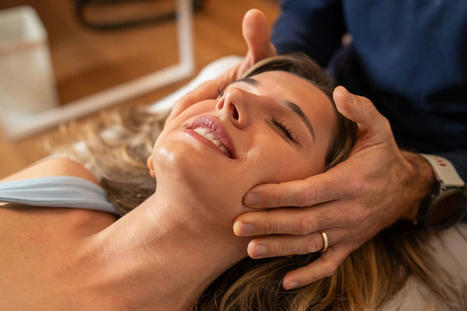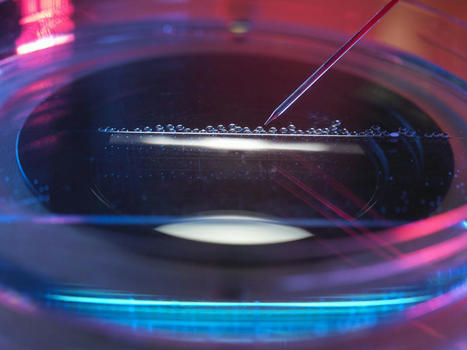For individuals suffering from neck pain and headaches, can craniosacral head massage therapy help provide relief?
Craniosacral Therapy
Craniosacral therapy is a gentle massage to release fascia or connective tissue network tension. The therapy is not new but has gained new attention because of the public interest in natural pain treatments and therapies. Studies are limited, but clinical research is ongoing to see if the therapy can become a mainstream treatment option. The therapy aims to alleviate the symptoms of various health ailments and conditions, including:
- Headaches
- Neck pain
- Complex regional pain syndrome - CRPS
- By relieving compression in the lower back, head, and spinal column, cerebrospinal fluid circulation is restored, and the body rhythms within the nervous system are reset. This provides pain relief, lowers stress, and improves overall well-being.
Massage Objectives
Several conditions and ailments said to benefit from craniosacral therapy include (Heidemarie Haller et al., 2019) (Heidemarie Haller, Gustav Dobos, and Holger Cramer, 2021)
- Headaches
- Migraines
- Chronic pain conditions
- Stress-related disorders
- Anxiety
- Depression
- Tinnitus - ringing in the ears
- Dizziness
- Infantile colic
- Gastrointestinal disorders
- Attention deficit hyperactivity disorder - ADHD
- Asthma
- Therapy to relieve cancer treatment side effects.
The focus areas are those along the fascia, the connective tissue that holds organs, blood vessels, bones, nerve fibers, and muscles in place. By working this tissue through gentle-pressure massage, practitioners help to calm the fight-or-flight response by relaxing the sympathetic nervous system. The symptoms will determine what areas of the body necessitate craniosacral therapy. Individuals with headaches will be given a head or neck massage. Other areas involved in craniosacral therapy include: (Heidemarie Haller, Gustav Dobos, and Holger Cramer, 2021)
- Back
- Around the spinal column.
- Other areas like the joints or muscles.
- The pressure applied during craniosacral therapy is light and not the same as a deep tissue massage.
- Light pressure is applied over the affected fascial tissue to help reset certain body rhythms that could play a role in pain and other symptoms. (Heidemarie Haller, Gustav Dobos, and Holger Cramer, 2021)
Parasympathetic and Sympathetic Nervous System
- The parasympathetic and sympathetic nervous systems control various body responses.
- The parasympathetic nervous system supports proper rest and digestive functions, and the sympathetic nervous system regulates the body’s fight-or-flight response. (Cleveland Clinic. 2022)
Therapy Techniques
The massage techniques used in craniosacral therapy rely on low pressure intended to be as gentle as possible. The fingertips are often used to avoid applying too much pressure. Healthcare providers work the areas between the skull and the bottom of the spine to identify and reset imbalances within the body and the cerebrospinal fluid. If there is an imbalance in cerebrospinal fluid, the massage therapist will reposition the individual or press on the area to release and/or increase circulation. The techniques work to improve the body’s ability to regulate physiological responses. (Heidemarie Haller et al., 2019) During and after the session, individuals may experience different sensations, including: (Biodynamic Craniosacral Therapy Association of North America, 2024)
- Relaxation.
- Feeling like being in a meditative state.
- Sleepiness.
- Energized.
- Feeling a sense of warmth.
- Deeper breathing.
- Feeling the body is straighter and taller.
Individuals Who Should Not Receive Craniosacral Therapy
Craniosacral therapy is considered safe; however, some individuals should avoid it or consult a healthcare provider before trying it. Those recommended not to receive the treatment include individuals with the following ailments or disorders:
- Concussion or other traumatic brain injuries.
- Blood clots.
- Brain swelling.
- Brain aneurysm - a blood-filled bulge in a blood vessel in or around the brain.
- Conditions that cause cerebrospinal fluid buildup.
Treatment
Craniosacral therapy is offered by several healthcare providers, including:
- Craniosacral therapy licensed massage therapists
- Physical therapists
- Occupational therapists
- Osteopaths
- Chiropractors
These professionals know how to perform the massage technique correctly.
Tension Headaches
The information herein is not intended to replace a one-on-one relationship with a qualified healthcare professional or licensed physician and is not medical advice. We encourage you to make healthcare decisions based on your research and partnership with a qualified healthcare professional. Our information scope is limited to chiropractic, musculoskeletal, physical medicines, wellness, sensitive health issues, functional medicine articles, topics, and discussions. We provide and present clinical collaboration with specialists from various disciplines. Each specialist is governed by their professional scope of practice and their jurisdiction of licensure. We use functional health & wellness protocols to treat and support care for the injuries or disorders of the musculoskeletal system. Our videos, posts, topics, subjects, and insights cover clinical matters, issues, and topics that relate to and directly or indirectly support our clinical scope of practice.* Our office has reasonably attempted to provide supportive citations and identified the relevant research studies or studies supporting our posts. We provide copies of supporting research studies available to regulatory boards and the public upon request.
We understand that we cover matters that require an additional explanation of how it may assist in a particular care plan or treatment protocol; therefore, to further discuss the subject matter above, don't hesitate to get in touch with Dr. Alex Jimenez or contact us at 915-850-0900.
Dr. Alex Jimenez DC, MSACP, CCST, IFMCP*, CIFM*, ATN*
email: coach@elpasofunctionalmedicine.com
Licensed in: Texas & New Mexico*
References
Haller, H., Lauche, R., Sundberg, T., Dobos, G., & Cramer, H. (2019). Craniosacral therapy for chronic pain: a systematic review and meta-analysis of randomized controlled trials. BMC musculoskeletal disorders, 21(1), 1. https://doi.org/10.1186/s12891-019-3017-y
Haller, H., Dobos, G., & Cramer, H. (2021). The use and benefits of Craniosacral Therapy in primary health care: A prospective cohort study. Complementary therapies in medicine, 58, 102702. https://doi.org/10.1016/j.ctim.2021.102702
Cleveland Clinic. (2022). Peripheral Nervous System (PNS) (Health Library, Issue. https://my.clevelandclinic.org/health/body/23123-peripheral-nervous-system-pns
Biodynamic Craniosacral Therapy Association of North America. (2024). What is a session like? https://www.craniosacraltherapy.org/what-is-a-session-like-



 Your new post is loading...
Your new post is loading...









Experience the benefits of craniosacral therapy. Find natural pain relief and improved well-being through gentle fascia release. For answers to any questions you may have, call Dr. Alexander Jimenez at 915-850-0900 or 915-412-6677